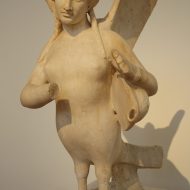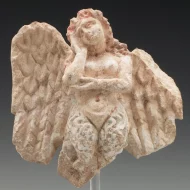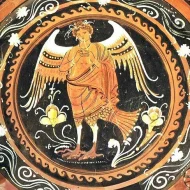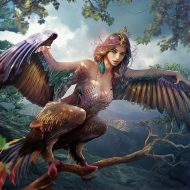Sirens : The Melodious Enchantress
Listen
At a glance
| Description | |
|---|---|
| Origin | Greek Mythology |
| Classification | Hybrids |
| Family Members | Achelous (Father), Gaia (Mother) |
| Region | Greece |
| Associated With | Seas, Sailors, Music |
Siren
Introduction
Amid the sun-soaked expanse of the Aegean, echoes of their captivating melody pirouetted on the briny breeze, drawing unwitting sailors towards a destiny as enchanting as it was perilous. These beings were the Sirens, mythical creatures whose bewitching voices promised paradise, only to ensnare those who yielded to their song in a fate marked by shipwrecks.
The Sirens, renowned figures from Greek mythology, are frequently portrayed as a hybrid of bird and woman, captivating seafarers with their irresistible songs that led them to inevitable doom. One of the most renowned tales featuring the Sirens unfolds in Homer’s epic poem, the “Odyssey.” These alluring entities, with their voices that prove impossible to resist and their captivating visage, have intricately woven themselves into the very fabric of ancient narratives. The Sirens, often depicted as enchanting maidens, have etched an indelible mark upon the domains of myth and folklore.
Physical Traits
Representations of the Sirens exhibit a diverse range, contributing to the enigmatic aura surrounding these mythical entities. In their early portrayals, they took on the semblance of monstrous birds, boasting the heads of exquisite women and feathers aglow with an otherworldly iridescence. Over time, these avian features underwent a softening transformation in later interpretations, casting the Sirens as alluring figures akin to humans. These depictions often featured them adorned in flowing robes and adorned with shimmering wings. Despite their outward beauty, a perilous undertone prevailed, with their eyes glinting a predatory gleam and their voices dripping with a hypnotic sweetness.
In the early manifestations within Greek art, the Sirens were typically depicted as large birds fused with women’s heads, featuring bird feathers and scaly feet. Subsequent artistic interpretations underwent a shift, presenting Sirens with human upper bodies coupled with bird legs, sometimes accompanied by wings. A recurrent theme in these depictions was the Sirens engaging in musical pursuits, often depicted playing instruments such as the lyre, kithara, and aulos, further emphasizing their enchanting and seductive nature.
Family
The lineage of the Sirens is a subject of diverse interpretations. Frequently, they are attributed as the offspring of the river god Achelous, with potential mothers listed as the Muse Terpsichore, Melpomene, Calliope, or Sterope, the daughter of King Porthaon of Calydon. An alternate lineage traces their origins to the sea god Phorcys. The parentage of the Sirens remains cloaked in mystery, with conflicting accounts proposing either Acheloos and Terpsichore or the monstrous sea-goddess Gaia as their progenitors. Regardless of this ambiguity, the Sirens did not exist in isolation. Often portrayed as a trio – Aglaope, Thelxiepeia, and Molpeia – they seamlessly blended their voices into a symphony of irresistible temptation.
In certain narratives, the Sirens find connection with the Muses, the esteemed goddesses of the arts and sciences. This linkage introduces an added layer of complexity to their character, suggesting that beyond luring sailors to their demise, their enchanting voices might also serve as a fount of inspiration for artistic creativity. The interweaving of the Sirens’ lineage with divine entities such as the Muses deepens the enigma surrounding these alluring beings, emphasizing their multifaceted nature within the tapestry of Greek mythology.
Other names
While the term “Siren” is the most commonly employed to denote these mythical beings, diverse traditions have assigned them different names. In Homer’s “Odyssey,” they go by the name “Seirenes,” a designation that has undergone translation and adaptation across various cultures. The Romans referred to them as “Sirenae,” and in certain accounts, they are simply known as “Harpies.” The Sirens transcend mere beauty and temptation; their various titles hint at different facets of their perilous allure.
They bear the names Acheloides, signifying their lineage as daughters of Acheloos, and the Peirenides, meaning “dwellers on the rocks,” a reflection of their hazardous coastal habitat. Among their chilling monikers is the Parthenioi, meaning “maidens,” a stark contradiction to the destructive power they wield. The individual names of the Sirens vary across later sources and include Thelxiepeia/Thelxiope/Thelxinoe, Molpe, Himerope, Aglaophonos/Aglaope/Aglaopheme, Pisinoe/Peisinoë/Peisithoe, Parthenope, Ligeia, Leucosia, Raidne, and Teles.
Powers and Abilities
The core potency of the Sirens resides in their captivating voices, which possess an alluring charm. Their songs, although melodious, carry the ability to enchant and captivate anyone fortunate enough to hear them. These enchanting melodies promise a wealth of knowledge, insight, and understanding, rendering them irresistible to those seeking wisdom. In certain accounts, the Sirens are also credited with the abilities of shapeshifting and telepathy.
The primary strength of the Sirens lies in the mesmerizing quality of their singing, a phenomenon recounted in mythology that draws sailors relentlessly toward the rocky shores where the Sirens await. The potency of their songs is so compelling that sailors often lose their sense of direction, succumbing to the temptation to follow the irresistible melodies, only to meet their doom.
The Sirens’ capacity to manipulate sound, captivating those who hear them, exemplifies a supernatural control over the senses. This power not only positions them as formidable adversaries in Greek mythology but also underscores the peril of yielding to the allure of the unknown. The Sirens’ songs, functioning as a metaphor for the temptations leading individuals astray, are meticulously crafted to exploit each listener’s deepest yearnings. The melodies strip away reason, igniting an insatiable longing for the fantastical world painted by their voices. The cunning hero Odysseus famously employed the strategy of plugging his crew’s ears with beeswax and lashing himself to the mast as the only means to resist the Sirens’ irresistible call.
In certain variations of the myths, the Sirens are attributed with prophetic abilities, offering glimpses into the future. This added layer of power elevates their status within the hierarchy of mythical beings, portraying them not only as enchantresses but also as seers endowed with insight into unfolding events.
Modern Day Influence
Sirens maintain their prominence as compelling figures in modern fantasy and fiction, as writers draw inspiration from Greek mythology to weave captivating tales around these seductive creatures. In contemporary literature, Sirens emerge as multifaceted characters, delving into themes of temptation, identity, and redemption. Their influence extends significantly into popular culture, where their enchanting songs and alluring presence find expression in literature, music, art, and film.
In the realm of popular culture, the Sirens endure as potent symbols. Whether embodied as alluring femme fatales in film noir or manipulative antagonists in fantasy novels, their echoes resonate across numerous narratives. Even in everyday life, we encounter “sirens” in the form of advertising, social media, and the constant influx of temptations vying for our attention.
The enduring power of the Sirens lies in their ability to reflect our deepest desires, serving as a reminder of the delicate balance between pursuing our dreams and succumbing to self-destruction. While their songs may be perilous, they ultimately offer a valuable lesson: true fulfillment is not found in fleeting pleasures, but in navigating the treacherous waters of temptation with reason and self-awareness as our guiding stars.
The music industry, too, bears profound influence from the concept of the Sirens. The notion of enchanting voices that captivate and enthrall permeates lyrics, album artwork, and stage performances. Musicians frequently incorporate elements of Siren mythology to evoke a sense of mystique and intrigue, establishing a profound connection between ancient tales and contemporary artistic expression.
Related Images
Frequently Asked Questions
What is lorem Ipsum?
I am text block. Click edit button to change this text. Lorem ipsum dolor sit amet, consectetur adipiscing elit. Ut elit tellus, luctus nec ullamcorper mattis, pulvinar dapibus leo.
What is lorem Ipsum?
I am text block. Click edit button to change this text. Lorem ipsum dolor sit amet, consectetur adipiscing elit. Ut elit tellus, luctus nec ullamcorper mattis, pulvinar dapibus leo.
What is lorem Ipsum?
I am text block. Click edit button to change this text. Lorem ipsum dolor sit amet, consectetur adipiscing elit. Ut elit tellus, luctus nec ullamcorper mattis, pulvinar dapibus leo.
What is lorem Ipsum?
I am text block. Click edit button to change this text. Lorem ipsum dolor sit amet, consectetur adipiscing elit. Ut elit tellus, luctus nec ullamcorper mattis, pulvinar dapibus leo.
What is lorem Ipsum?
I am text block. Click edit button to change this text. Lorem ipsum dolor sit amet, consectetur adipiscing elit. Ut elit tellus, luctus nec ullamcorper mattis, pulvinar dapibus leo.








